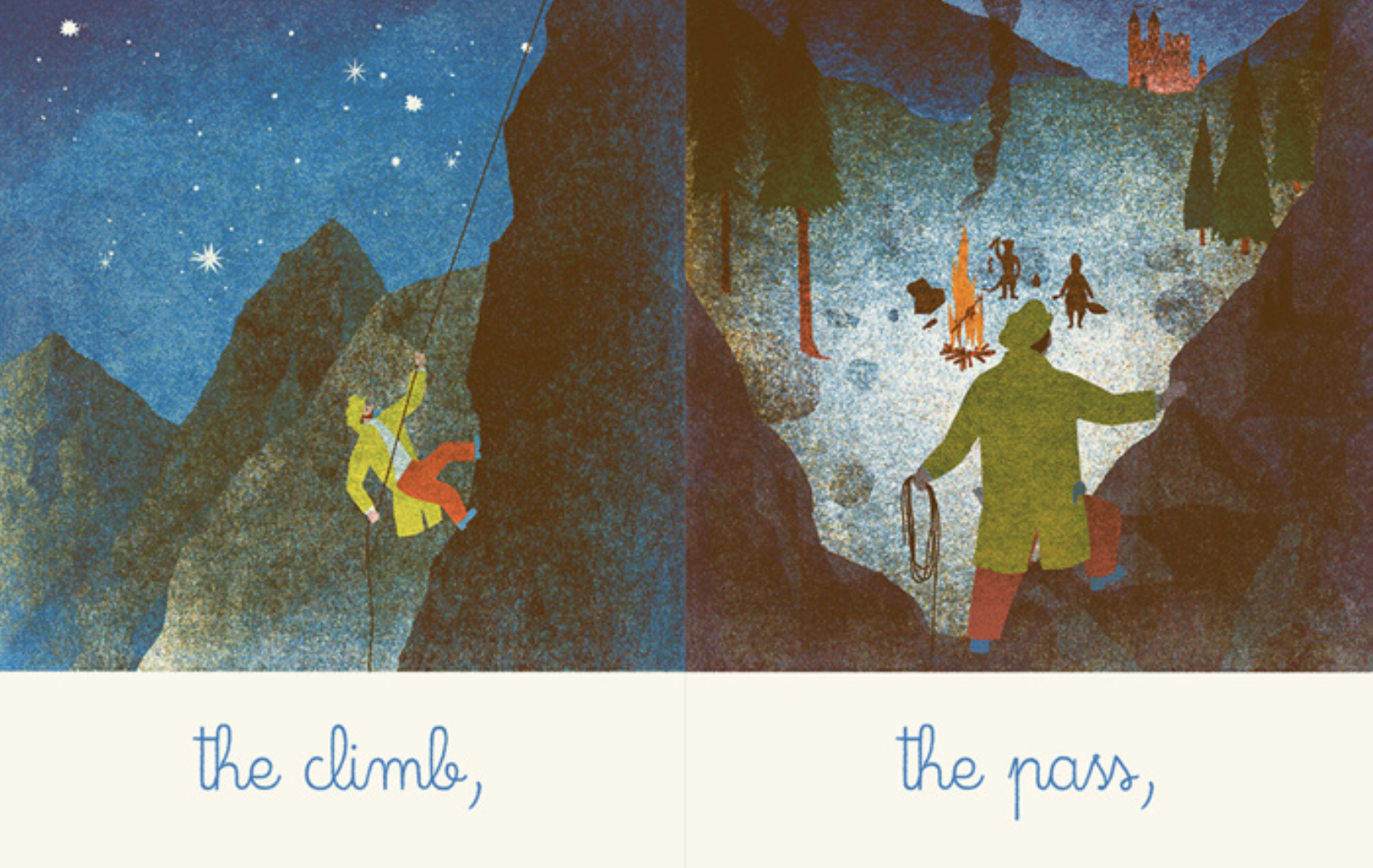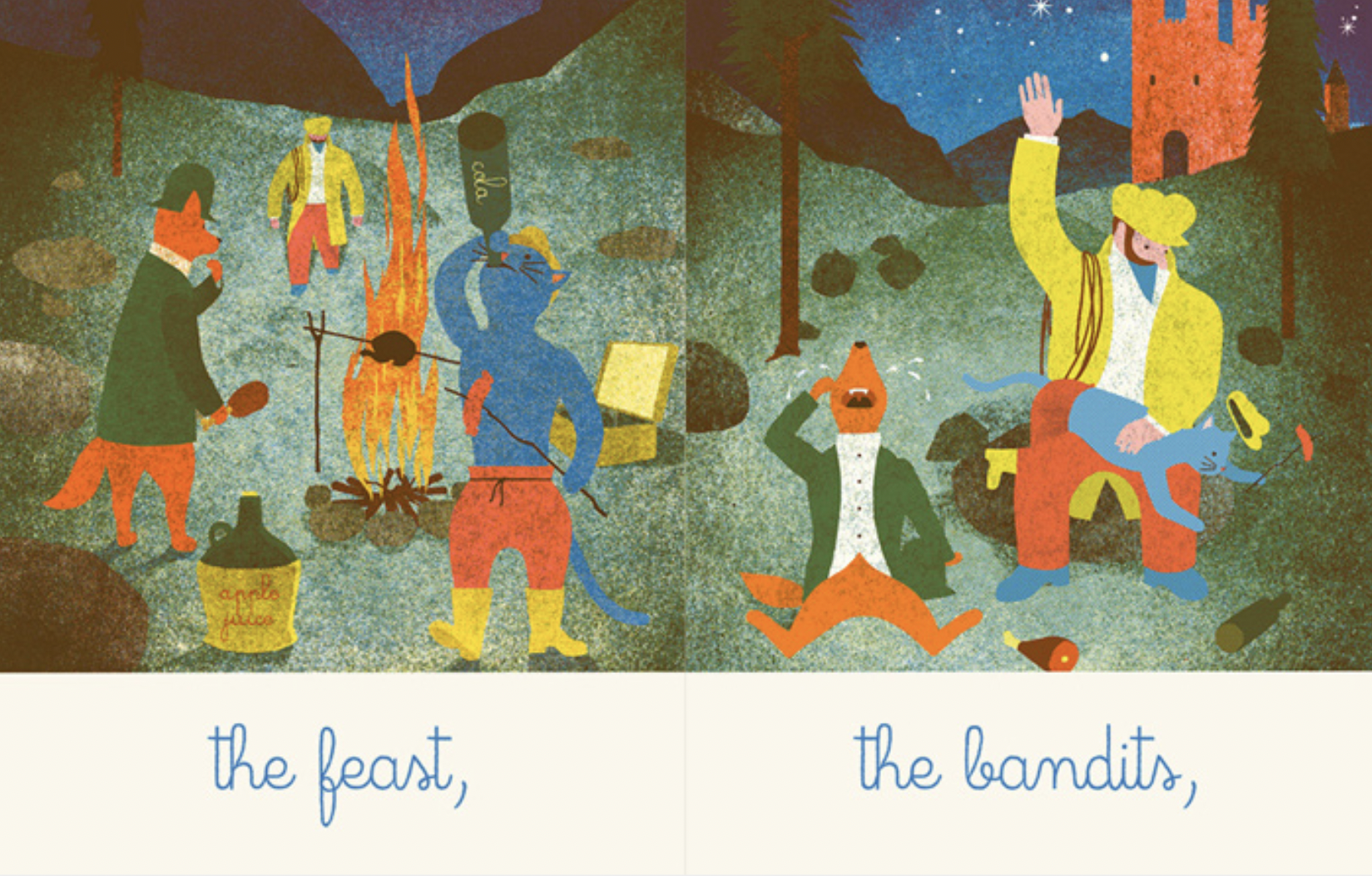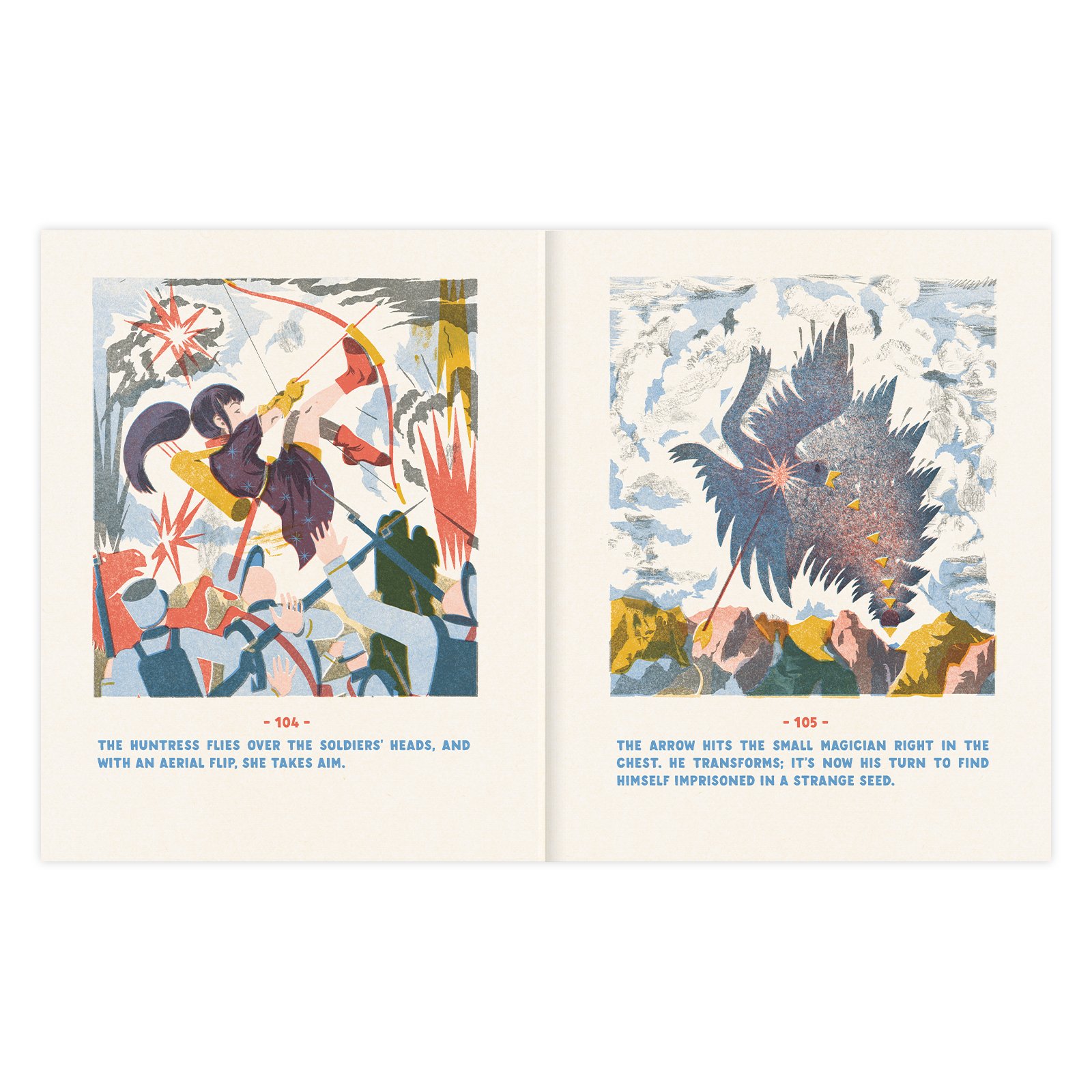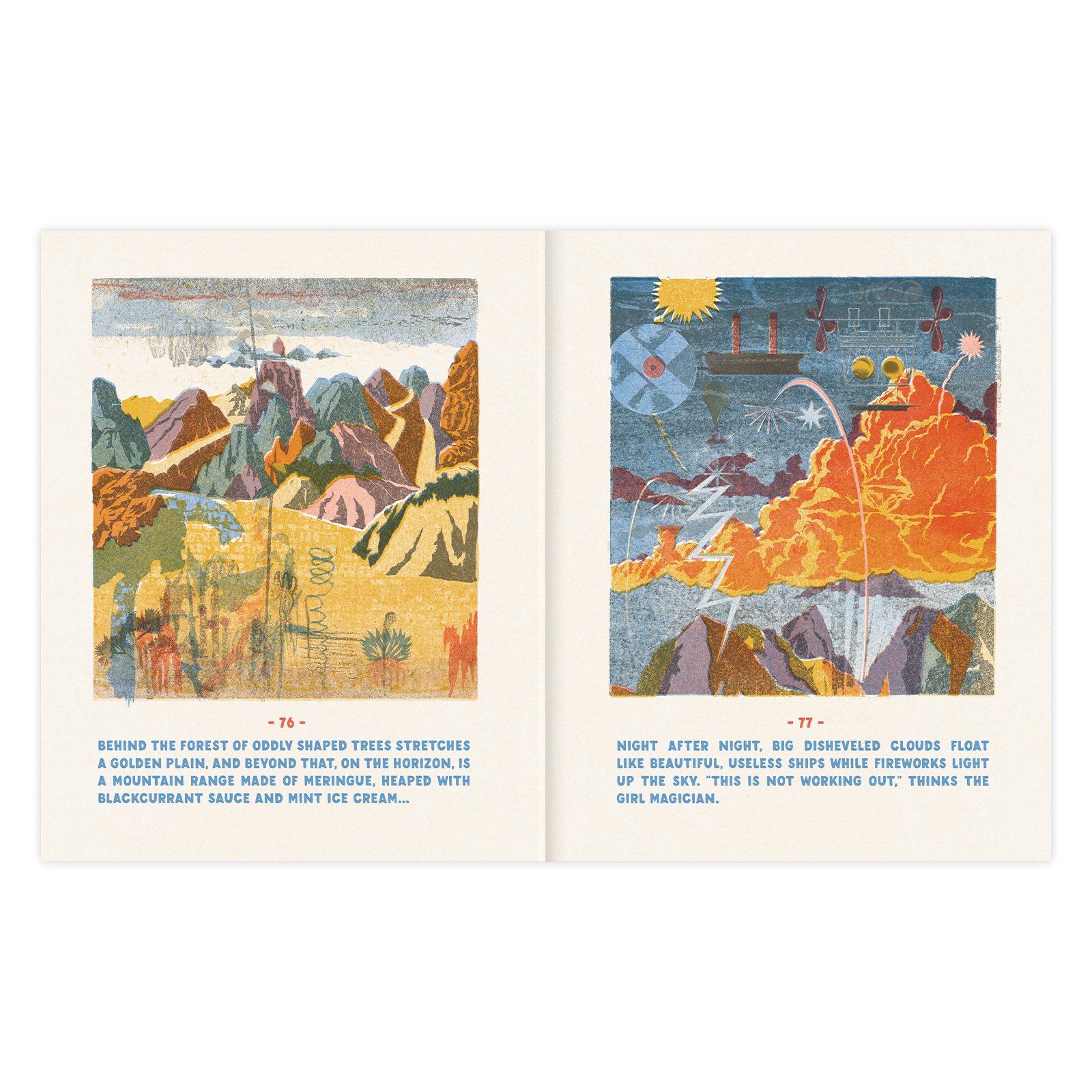A Conversation with Blexbolex, Author & Illustrator of THE MAGICIANS
Blexbolex is an award-winning book illustrator. Born in France, he has lived in Germany since 2008, where he teaches and also gives workshops. In 1992, he started work as a printer, allowing him to both create and print his own first books. From 1996 to 2005, he worked at Éditions Cornélius in Paris. Since 2005, he’s worked as an illustrator and author of children’s books, while also creating comics and books for adults. His experimental approach to illustration, industrial printing techniques, and book production makes him a pioneer in his field. Blexbolex has received many prizes and distinctions, including New York Times Best Illustrated recognitions for Seasons (2010) and Ballad (2014).
The Magicians—published on November 7, 2023, and greeted with a flurry of starred reviews—is his fifth book with Enchanted Lion. We asked him a few questions about this visually stunning, 200-plus-page tour de force.
Enchanted Lion: Blexbolex, thank you so much for agreeing to answer our questions. We’re excited to discuss The Magicians with you!
Blexbolex: Before we get started, I’d like to thank Enchanted Lion for choosing to publish this book and proposing it to your readers. It’s a somewhat challenging book in the sense that its format isn’t immediately identifiable: it’s in between graphic novel and picture book.
Personally, I tried to think of The Magicians as a tide of images and texts, carrying not ideas, necessarily, but rather a set of situations and sensations. My biggest challenge was to put them in order and arrange them in a natural way, so as not to lose any in the process and to preserve their initial spark. In this sense, I’ve stayed in the same vein of the imagier* (People, Seasons, and Ballad), but taking a different perspective.
[*NOTE: An imagier refers to a book of images. Usually each image is paired with the name of what is represented, or a short caption. Often collecting images around a certain theme, these books are traditionally used to teach young children how to identify various people, places, concepts, or things.]
EL: What draws you to the subject of magic… and the struggle to keep magic alive?
B: I can’t really answer this question, as I wasn’t really the one who chose the book’s theme, or even the way it ended up being expressed. The scenes imposed themselves on me, it’s that simple. You could describe it as a waking dream, if you like: I’m sitting on my sofa and letting my mind drift. Images emerge, and if they please me, I let them go wherever they desire. This time, the images went relatively far and I made the effort to get them down on paper.
I should clarify that this stage doesn’t yet constitute a story, these are merely scenes and images that have yet to take shape. If I’m inspired, or inspired enough, shaping these undefined images into their graphic, artistic, or narrative form consists of faithfully capturing—or even rediscovering—this same kind of firework display of mental images and sensations. Therein lies the real work, and this time there’s nothing magical about it.
EL: The three child magicians (a human girl, a blackbird, and an elephant) at the center of the story are all bursting with personality. How did the characters come to influence the plot, and vice versa?
B: The characters carry the full potential of the narrative in and of themselves. They’re like balls of yarn that must be untangled and unwound. It’s a delicate undertaking: you can’t pull the yarn too fast or too hard. If you do, you’ll either snap the string, or end up with a tangled web of knots. I don’t use any particular technique; I go step by step, little by little. Once one section is freed, I fix in place what I’ve just unspooled to avoid losing it and continue to pull as hard and as far as I can. This often forces me inspect the “thread” to ensure that it’s neither broken nor tangled up.
EL: How did you come up with the Huntress’s sidekick… the mechanical lion dragon, Clinker?
B: His head is of course borrowed from Chinese culture, and it follows that his body, made up of balls or circles, is too, since he’s one of those wonderful Chinese kites. My only contribution here was to give him dragon legs so that he could walk and run. He’s somewhere between animal and machine, almost like a big toy, but endowed with speech, soul, and personality. If you ask me, I think he’s animated by air, but I couldn't prove it, of course.
EL: Which artists or writers influenced you and The Magicians, if any?
There are so many artists and writers that inspired The Magicians that I could never cite all of them, nor do them justice, nor express my gratitude! Sometimes I borrowed a lone word, a single turn of phrase, a bit of an image! To make a complete and precise inventory of them all, I would need to unravel my own work, and I surely don’t wish to do that.
EL: What have you drawn on from your own childhood to make this book?
Everything and nothing in particular. In almost all of my books, I try to recreate one or more sensations, whether they come from childhood or more recent experiences, and this latest book is no exception. Some sensations, whether they’re memories or something else, remain very vivid and I don’t need to explain them to myself. But on occasion, a recent event will lead me to ask myself questions about older situations, situations that have already been experienced in some way.
That’s when I feel the need to somehow go back in time or carry out a sort of investigation, in order to find, or even sometimes explain, the origin of this sensation. It could be described as a fairly Proustian approach—all things considered!—, beyond the literary, historical, or familial dimensions.
EL: How would you describe the magic in your book?
B: The magic as expressed in the book is natural, even elemental, to our world, but at the same time involves a supernatural reality (the “Outside” passage). One could say that nature (or at least its magical quality) very partially reflects this supernatural reality (the world in which magic finds its source), precisely because it is its flip side. The natural world and the supernatural world are on opposite sides of each other. Following this line of thinking, the magic described here should therefore never be able to find its place in our world.
This is why the magicians are so important. It's their capacity to cross from one side to the other that explains the presence of magic on this side of the coin, in “our” world. One could imagine that their ability creates a sort of distortion and bends space, or rather the structure, of the world imagined in his story, much like a Möbius strip, which has only one side. It’s this strange talent that might explain why the magicians are neither good nor evil, neither solely human nor totally animal, etc. It’s simply their way of being.
Finally, the kind of magic in this story expresses itself very classically: through illusion and manipulation, and essentially by way of things that already exist (wind, fire, plants, human, desires, etc.).
EL: You’ve said your narrative structure echoes that of video game play. How so?
B: More than video games, it’s game design and its underlying philosophy that interests me. Creating fiction is difficult. Truth be told, I don’t understand how it works. No matter how much I read and read about the art of the novel or the art of theater or dramaturgy, I never find anything that’s felt particularly convincing to me, even though I’ve tried to give it my all.
The implicit rules of a game and their logical consequences on the round of the game that the player will play helped me to understand certain dramaturgical rules that had previously eluded me. I think that some of the techniques devised by game developers can be applied to fiction—and I suspect that some of these techniques actually come from classical dramaturgy, which is entertaining to imagine even if it isn’t true…
EL: There are more than 180 nearly full-page illustrations in this book, all gorgeously created to look like silkscreen printing. What was your process in creating this beautiful artwork? How long did it take?
B: This book was unusually long and challenging to conceive. The hardest part was becoming acquainted with the characters, since accessing all the rest of the story hinges on them. I’ve lost count of the false starts, failures, and rewrites of this simple beginning… suffice it to say, I spent an entire year attempting to solve just this problem.
It was truly nightmarish. I tried everything but the kitchen sink, or almost: from which pictorial technique to choose, to how to lay out the text on the page, etc. I ended up with almost as many of these attempts as there are pages in the book.
Out of desperation, I decided to make the images in stencil form, which helped me simplify my shapes and streamline the color system. The layout and the poster-like look of the pages arise from this technique, inspired by Russian luboks, particularly those of Mayakovsky. Once I landed on this particular form, which gives each page a sense of unity (here, it’s the images that are numbered, not the pages), everything got simpler, and the rest is just my “secret sauce.”
From the time when this dream was jotted down as notes on a page to the time I turned in the last files to my publisher, I'd say four years had probably gone by. But honestly, I’m not sure anymore.
EL: The Magicians—with its metallic endpapers, French flaps, and comics-style paper—is a work of art in itself. Is the finished book as you originally envisioned it?
B: Overall, yes, the book is what I had hoped it would be from the start. A book should have its own scenography, which forms part of its own particular dramaturgy. The design elements are “dressing,” of course, but they create the kind of ceremony that makes up the reading experience, especially for this kind of book. It’s important because it sets the framework for reading, and isolates it from ordinary activities. For example, the metallic endpapers play their role: that of a curtain to pass through, to enter into this world of fiction.
EL: Finally, is there a question you always wish someone would ask you, but they never do?
B: Yes: “How are you?” That simple question would stun me and reduce me to total silence.









